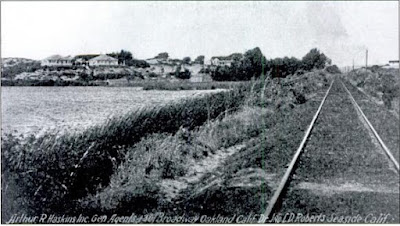 |
| Seaside, as shown on the 1947 USGS Map. |
The railroad conveniently passed directly through the heart of East Monterey. The composition of the station structure is not currently known to this historian but records show that a station was present for the town. Beside the tracks, a siding of variable length—no longer than 500 feet—paralleled the mainline on the west side. A short spur running to the freight platform and station, meanwhile, sat on the east side of the mainline, just beyond the northern end of Hillsdale Street.
 |
| Seaside subdivision plan, c. 1908. This map shows the extension of East Monterey into the "Seaside Addition", which marked the community's transformation. (Fine Art America) |
 |
| The railroad tracks in Seaside, 1917. (City of Seaside Archives) |
Railroad service to the station increased through the 1930s and 1940s, probably reaching a height in the 1950s before declining rapidly as regular passenger services ended. Freight service to Seaside remained intermittently, although what it serviced is not entirely known. Numerous small freight concerns existed in the area but changed frequently. Which, if any, of them used the Seaside freight platform after 1954 is unknown currently. The station became the end-of-track when the branch was truncated in 1979 and remained on timetables until the abandonment of the branch by the Union Pacific Railroad in 1999. When the station structure was removed is currently unknown.
Official Railroad Information:
East Monterey probably first appeared around 1889 with a class-A freight platform. It was renamed Seaside by 1899. In the 1920s, the station's platform was downgraded to a C-class freight stop, meaning it had a platform and siding but no other facilities. The stop was located 123.3 miles from San Francisco via Castroville, Gilroy, and San José. It was also 6.7 miles from the Lake Majella end-of-track. Initially, it offered both passenger and freight service and included a 10-car (~500 foot) siding at the stop. The siding shrunk down to ~450 feet by 1940 and then ~250 feet by 1951. Regularly-scheduled passenger service, except for specials such as the Del Monte Express, ceased in 1963 and the siding disappeared from timetables at the same time. In 1979, the Monterey Branch was cut back, with Seaside becoming the new end-of-track. The station remained on timetables until the closure of the branch in 1999.
Geo-Coordinates & Access Rights:
36.61˚N, 121.85˚W
The site of Seaside is beneath the Cardinale Nissan dealership on Del Monte Blvd. The parking lot marks the extent of the spur and station property while the siding ran from the end of Holly Street to just southwest of where the right-of-way passes over Contra Costa Street. Access to the right-of-way is largely open in this area, except for the Nissan dealership.
Citations & Credits:
- McKibben, Carol Lynn. Images of America: Seaside. Arcadia Press, 2009.

There is a major misconception going around that the Del Monte, discontinued in 1971, was
ReplyDeletecalled the Del Monte Limited or the Del Monte Express or the Del Monte Special in it's later years of operation. According to Lucius Beebe in his classic reference book THE CENTRAL
PACIFIC AND THE SOUTHERN PACIFIC RAILROADS. p. 624, it was called the Del Monte
Limited only until 1891. Until June 1927, it was the Del Monte Express. Then it became just
two words: DEL MONTE. It remained this way until the train was discontinued in 1971.
Because it ran every day, whether or not it was "special" may be up for debate. If you saw
what this train looked like in the 1960's as I did, you probably would not have called it "special".
It was being pulled by one or two GP9 diesels with two or three coaches. The schedule for
the Del Monte at Seaside is a little complicated. It was usually a flag stop for the Del Monte
from at least the 1950's onward but it is shown as a regular stop for the southbound Del Monte
daily except Sundays & Holidays in the Sept. 30, 1951 schedule. By Jan. 15, 1954 when I have
my next timetable, Seaside is shown as a flag stop in both directions. Seaside remained on the
employee's and public timetables as a daily flag stop through the final run on April 30, 1971.
The only change in the Del Monte's schedule in 1963 was that the northbound train
started running an hour later and the train number changed from # 139 to # 141 because
of a new hookup in San Jose with a later commuter train to San Francisco. Seaside remained
a flag stop for the Del Monte until the end in 1971.